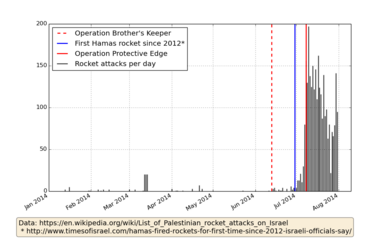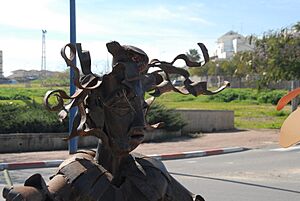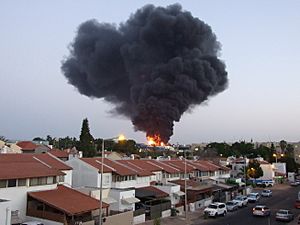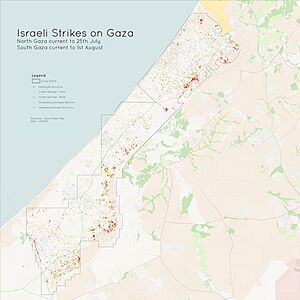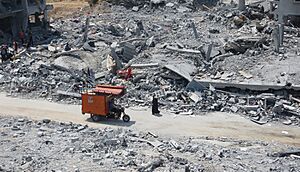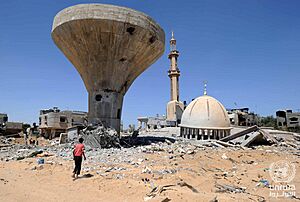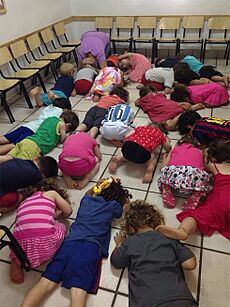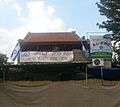2014 Gaza War facts for kids
Quick facts for kids 2014 Gaza War |
|||||||
|---|---|---|---|---|---|---|---|
| Part of the Gaza–Israel conflict | |||||||
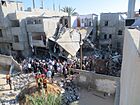 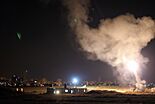 Left, right:
|
|||||||
|
|||||||
| Belligerents | |||||||
|
|
|||||||
| Commanders and leaders | |||||||
(Prime Minister) (Defense Minister) (Chief of General Staff) (Air Force Commander) (Naval Commander) (Southern Commander) (Gaza Division) (Chief of Shin Bet) |
(Leader of Hamas) (Deputy Chief of Hamas) (Head of Izz ad-Din al-Qassam Brigades) (Leader of the Palestinian Islamic Jihad) |
||||||
| Units involved | |||||||
|
|
|||||||
| Strength | |||||||
| 176,500 active personnel 565,000 reservists (2012 figures, of which not all are directly involved) |
Al-Qassam Brigades: 20,000–40,000 |
||||||
| Casualties and losses | |||||||
| 67 soldiers killed 469 soldiers wounded 2 soldiers captured 6 civilians (1 Thai) killed 87 civilians wounded |
Gaza Health Ministry: 2,310 killed (70% civilians), 10,626 wounded UN HRC: 2,251 killed (65% civilians) B'Tselem: 2,203 killed (64% civilians) Israeli government: 2,125 killed (44% combatants) PCHR: 2,216 killed (69% civilians) |
||||||
| More than 23 Palestinians executed by Hamas or Al‑Qassam for alleged espionage. | |||||||
The 2014 Gaza Conflict, also known as Operation Protective Edge in Israel, was a period of intense fighting between Israel and Palestinian groups in the Gaza Strip. It lasted for seven weeks, from July 8 to August 26, 2014. This conflict was one of the most serious outbreaks of violence in the long-standing Israeli–Palestinian conflict.
The fighting began after the disappearance and tragic deaths of three Israeli teenagers in the West Bank. Israel blamed Hamas for this event. Following this, Israel launched an operation to arrest members of Hamas. Hamas then started firing rockets towards Israel.
Israel's main goal was to stop these rocket attacks from Gaza. Palestinian groups, including Hamas, aimed to pressure Israel to lift its restrictions on the Gaza Strip. They also wanted to end Israeli attacks and secure the release of some Palestinian prisoners.
During the conflict, Israeli forces carried out airstrikes and a ground operation in Gaza. They aimed to destroy tunnels used by Palestinian groups. Palestinian groups fired thousands of rockets and mortars into Israel. Israel's Iron Dome defense system intercepted many of these rockets.
Sadly, many people were affected. Over 2,000 Palestinians in Gaza lost their lives, most of whom were civilians. Thousands more were injured, including many children. Many homes in Gaza were destroyed or damaged, leaving families without shelter. On the Israeli side, 67 soldiers and 6 civilians were killed. Hundreds of soldiers and civilians were also injured. The conflict also had a significant economic impact on both sides.
Contents
Why the Conflict Started
A Look at the Background
The Gaza Strip is a Palestinian territory. In 2005, Israel withdrew its soldiers and settlers from Gaza. However, Israel still controls Gaza's borders, airspace, and sea.
In 2006, Hamas, a Palestinian group, won elections in Gaza. This led to a power struggle with another Palestinian group, Fatah. In 2007, Hamas took full control of Gaza. After this, Israel placed economic and political restrictions on Gaza. These restrictions, often called a blockade, have caused many problems for people living there. Israel says the blockade is needed to stop rocket attacks and prevent weapons from entering Gaza.
There have been other conflicts between Israel and Gaza. In 2008, Israel launched an operation to stop rocket attacks. In 2012, another conflict led to a ceasefire agreement. This agreement aimed to stop fighting and open border crossings.
Challenges to Peace
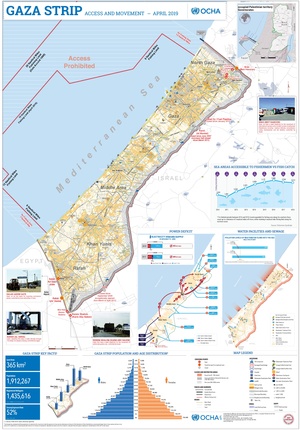
Even after the 2012 ceasefire, there were still challenges. Both sides accused each other of breaking the agreement. Rockets were sometimes fired from Gaza into Israel. Israel also carried out attacks inside Gaza.
In 2014, Hamas and Fatah agreed to form a unity government. This was a big step for Palestinian groups. However, Israel was concerned about this new government.
The Spark of the Conflict
In June 2014, three Israeli teenagers disappeared in the West Bank. Israel blamed Hamas for their deaths. This led to a large search operation by Israel in the West Bank. Many Palestinians were arrested during this time.
As tensions grew, rockets were fired from Gaza into Israel. Israel responded with airstrikes on targets in Gaza.
Hamas then took responsibility for firing rockets. They demanded that Israel end its attacks and lift the blockade on Gaza. This led to the start of the 2014 Gaza Conflict.
How the Conflict Affected People
Impact on Gaza Residents
The conflict had a huge impact on people in Gaza. Hospitals struggled with shortages of medicine and supplies. Food prices went up, making it hard for families to buy what they needed.
Many people had to leave their homes to find safety. Over 273,000 Palestinians were displaced. Many found shelter in schools run by the United Nations. These shelters became very crowded.
The conflict also damaged important services. Water supplies were reduced, and electricity was available for only a few hours a day. This affected public health and sanitation. Many schools and health centers were also damaged.
Thousands of homes were destroyed or badly damaged. For example, in Beit Hanoun, 70% of homes were damaged. This left many families without a place to live. Factories, farms, and even historic mosques and churches were also hit.
Children in Gaza were especially affected. Many needed psychosocial support to help them cope with the stress and trauma. The damage to homes and infrastructure meant that rebuilding Gaza would take many years and billions of dollars.
Impact on Israeli Residents

People in Israel also faced challenges. Hamas and other groups fired rockets and mortars at Israeli towns. While the Iron Dome system stopped many rockets, some still got through. Six civilians were killed, and many were injured.
Rocket attacks caused damage to homes, factories, and other buildings in Israel. Many people had to stay close to bomb shelters. Summer camps and large gatherings were cancelled for safety. Flights at Ben-Gurion Airport were also affected.
Some communities, like Bedouin villages, did not have warning sirens or shelters. This left their residents more vulnerable to rocket attacks. Thousands of Israelis temporarily left their homes to escape the danger.
The conflict also had an economic cost for Israel. Businesses were affected, and there were costs for military operations and repairing damage.
Casualties and Losses
The conflict resulted in many deaths and injuries on both sides. Most sources agree that between 2,125 and 2,310 Palestinians in Gaza were killed. A large percentage of these, about 64-70%, were civilians. Over 10,000 Palestinians were wounded.
On the Israeli side, 67 soldiers were killed. Six Israeli civilians also lost their lives due to rocket and mortar fire. More than 460 soldiers and 260 civilians were injured.
These numbers show the tragic human cost of the conflict for both Palestinians and Israelis.
Economic Impact of the Conflict
The conflict caused significant economic damage. In Gaza, thousands of homes were destroyed or severely damaged. This meant that rebuilding would cost billions of dollars and take many years. Factories, power plants, and water systems were also damaged. This made daily life very difficult for Gazans.
Tunnels used for smuggling goods into Gaza were also destroyed. These tunnels had been important for Gaza's economy due to the blockade. The conflict also affected farming and livestock in Gaza.
For Israel, the conflict also had a financial cost. It was estimated to be around $2.5 billion. This included military spending and costs for repairing damage to property.
Efforts to Rebuild Gaza
After the conflict, an international conference was held in Cairo. Countries pledged billions of dollars to help rebuild Gaza. However, progress has been slow. Many Gazans remained homeless months after the fighting ended.
Aid organizations have expressed concern about the slow pace of reconstruction. They have called for the blockade on Gaza to be lifted. This would allow more building materials and aid to enter.
There have been challenges in getting aid to those who need it. Some reports suggested that building materials were not reaching civilians. Both Israel and Palestinian groups have been blamed for these delays.
Images for kids
-
A pro-Palestinian protest in Berlin in July 2014.
-
A pro-Israel demonstration in Helsinki, Finland.
-
U.S. Secretary of State John Kerry and Benjamin Netanyahu in Tel Aviv, July 2014.
-
A demonstration against the conflict in Tel Aviv, Israel.


